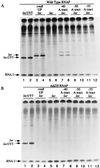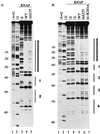Upstream A-tracts increase bacterial promoter activity through interactions with the RNA polymerase alpha subunit
- PMID: 9843944
- PMCID: PMC24504
- DOI: 10.1073/pnas.95.25.14652
Upstream A-tracts increase bacterial promoter activity through interactions with the RNA polymerase alpha subunit
Abstract
Upstream A-tracts stimulate transcription from a variety of bacterial promoters, and this has been widely attributed to direct effects of the intrinsic curvature of A-tract-containing DNA. In this work we report experiments that suggest a different mechanism for the effects of upstream A-tracts on transcription. The similarity of A-tract-containing sequences to the adenine- and thymine-rich upstream recognition elements (UP elements) found in some bacterial promoters suggested that A-tracts might increase promoter activity by interacting with the alpha subunit of RNA polymerase (RNAP). We found that an A-tract-containing sequence placed upstream of the Escherichia coli lac or rrnB P1 promoters stimulated transcription both in vivo and in vitro, and that this stimulation required the C-terminal (DNA-binding) domain of the RNAP alpha subunit. The A-tract sequence was protected by wild-type RNAP but not by alpha-mutant RNAPs in footprints. The effect of the A-tracts on transcription was not as great as that of the most active UP elements, consistent with the degree of similarity of the A-tract sequence to the UP element consensus. A-tracts functioned best when positioned close to the -35 hexamer rather than one helical turn farther upstream, similar to the positioning optimal for UP element function. We conclude that A-tracts function as UP elements, stimulating transcription by providing binding site(s) for the RNAP alphaCTD, and we suggest that these interactions could contribute to the previously described wrapping of promoter DNA around RNAP.
Figures




References
-
- Record M T, Jr, Reznikoff W S, Craig M L, McQuade K L, Schlax P J. In: Escherichia coli and Salmonella, Cellular and Molecular Biology. Neidhardt F C, editor. I. Washington, DC: Am. Soc. Microbiol.; 1996. pp. 792–820.
-
- Banner C D, Moran C P, Jr, Losick R. J Mol Biol. 1983;168:351–365. - PubMed
-
- McAllister C F, Achberger E C. J Biol Chem. 1988;263:11743–11749. - PubMed
-
- Lavigne M, Herbert M, Kolb A, Buc H. J Mol Biol. 1992;224:293–306. - PubMed
Publication types
MeSH terms
Substances
Grants and funding
LinkOut - more resources
Full Text Sources
Other Literature Sources

